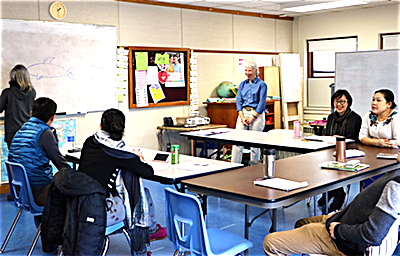- By Naomi Himes
- Around Town
 Print
Print
Adult students enrolled at the English as a Second Language (ESL) program through TST BOCES are learning so much more than just the English language; they are learning how to be a part of their new Ithaca and U.S. communities.
Julie Rudd Coulombe, Coordinator of the TST BOCES Adult ESL Program, says that the goal of her classes is to not only teach English, but to help her students feel like they are welcome. "Learning English here is a lot more than learning colors and numbers," said Coulombe. "We want our students to be able to connect with native English-speakers and feel a part of the Ithaca community."
The TST BOCES Adult ESL classes take regular field trips to places like the supermarket, to help support authentic conversational experiences. The ESL teachers are there every step of the way to facilitate understanding of word meaning in context.
"It's really important to us that they can have a real conversation with someone," said Coulombe.
Other places the students have visited include the Women's Rights National Historical Park in Seneca Falls, the Harriet Tubman Home in Auburn, local greenhouses, fire stations, the History Center in Tompkins County, Ithaca Town Court and more.

A big part of the program is connecting the students with the resources necessary to be successful, such as Adult Education trainings offered through TST BOCES, higher education opportunities and citizenship classes. The TST BOCES Adult ESL program works closely with local community organizations like Tompkins Learning Partners and the Immigrant Services Program through Catholic Charities.
Coulombe estimates that more than 8,000 adults have taken English classes at BOCES over the past 20 years. Currently, there are 177 active students, and 170 have exited, so a grand total of 347 students have been enrolled in the program since the beginning of last July. Class size ranges from five to 20 students.
One of the challenges the teachers have learned to overcome is the ability to teach a student English without any knowledge of that student's native language. With five to 15 different native languages in a class at any given time, it is impossible for teachers to have fluency in them all. The teachers rely heavily on being very expressive and using real-life examples to demonstrate meaning.
Coulombe says that it takes a special skill to teach English in this manner, and it's another reason why class field trips are so beneficial to the program. Two of her teachers will be presenting at a state-wide conference in April to share some of their best teaching techniques.
v12i15
Julie Rudd Coulombe, Coordinator of the TST BOCES Adult ESL Program, says that the goal of her classes is to not only teach English, but to help her students feel like they are welcome. "Learning English here is a lot more than learning colors and numbers," said Coulombe. "We want our students to be able to connect with native English-speakers and feel a part of the Ithaca community."
The TST BOCES Adult ESL classes take regular field trips to places like the supermarket, to help support authentic conversational experiences. The ESL teachers are there every step of the way to facilitate understanding of word meaning in context.
"It's really important to us that they can have a real conversation with someone," said Coulombe.
Other places the students have visited include the Women's Rights National Historical Park in Seneca Falls, the Harriet Tubman Home in Auburn, local greenhouses, fire stations, the History Center in Tompkins County, Ithaca Town Court and more.

A big part of the program is connecting the students with the resources necessary to be successful, such as Adult Education trainings offered through TST BOCES, higher education opportunities and citizenship classes. The TST BOCES Adult ESL program works closely with local community organizations like Tompkins Learning Partners and the Immigrant Services Program through Catholic Charities.
Coulombe estimates that more than 8,000 adults have taken English classes at BOCES over the past 20 years. Currently, there are 177 active students, and 170 have exited, so a grand total of 347 students have been enrolled in the program since the beginning of last July. Class size ranges from five to 20 students.
One of the challenges the teachers have learned to overcome is the ability to teach a student English without any knowledge of that student's native language. With five to 15 different native languages in a class at any given time, it is impossible for teachers to have fluency in them all. The teachers rely heavily on being very expressive and using real-life examples to demonstrate meaning.
Coulombe says that it takes a special skill to teach English in this manner, and it's another reason why class field trips are so beneficial to the program. Two of her teachers will be presenting at a state-wide conference in April to share some of their best teaching techniques.
v12i15



